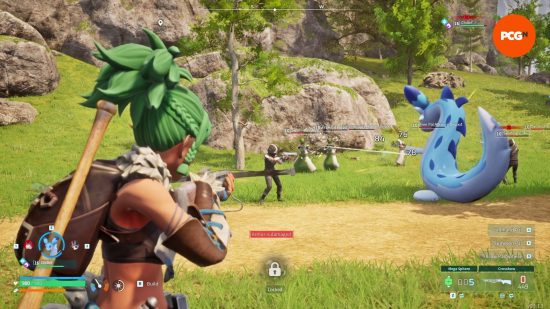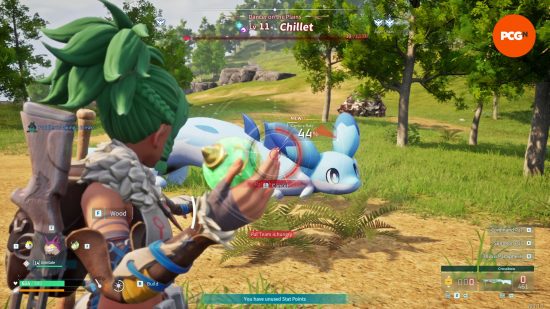In 1913, Henry Ford implemented the first moving assembly line. In Palworld, I’m managing a weapons production facility of anthropomorphic cats and feeling pretty icky about it. Pocketpair’s Pokémon PC game has been in the pipeline for years, but watching a videogame protagonist use a cartoon lamb as a meat shield sure sticks in the mind. This brand of provocative subversion of beloved childhood media isn’t new – it’s practically a whole internet subgenre at this point – but we rarely see it come to fruition where pocket monsters are concerned. Well, rise and grind, Pikachu. It’s here now.
‘Pokémon with guns’ is Palworld’s pitch, though that’s something of a misnomer. Palworld is to Pokémon fans what Ark is to dinosaur fans, but it also takes clear inspiration from the likes of Breath of the Wild, Elden Ring, and Monster Hunter. This mish-mash of critically acclaimed open-world game design paired with the tried-and-tested gameplay loop present in Ark, Valheim, and countless other survival games ensures that Palworld is both well-grounded and familiar. Conversely, the linear framework of games like Pokémon is almost absent. Instead, I’m washed ashore on Palpagos Island and left to fend for myself, with little more than a laissez-faire nod towards the island’s boss towers. From there, it’s a case of attending to my basic needs and catching a Pal, or two, or three, or – you get the idea.
Thankfully, Palworld’s survival mechanics aren’t punishing by default. I don’t immediately drop dead if I forget to eat, and custom difficulty options give me ample freedom to choose my preference: whether that’s a relaxed approach to hunger and stamina or an unforgiving death penalty that causes me to lose everything. Like most survival games, progression is tied to a technology tree replete with new structures and items. While many early unlocks are par for the course, later tiers grant me access to Palworld breeding farms, rocket launchers, and of course, assembly lines.
While I went into Palworld expecting to be led down a less-than-merry path of animal butchery and penal colonies, its player agency remains blessedly neutral. I’m free to capture, kill, or leave wild Pals to their own devices. I can subsist entirely off berries. I could, hypothetically, do the bulk of the Palworld base building and crafting myself, though that kind of defeats the purpose. On the flip side, I could impose a brutal work regime, but this only harms my Pals (and their production) in the long run. It also turns out that chopping up Pals is pretty counterintuitive, though I do find myself in the surreal position of watching one dutifully craft the cleaver required for the purpose. Regardless, while these options exist, Pocketpair doesn’t opt to wave them in my face if I choose to ignore them.
The uncanny resemblance of Palworld Pals to Pokémon has served developer Pocketpair very well in terms of viral marketing, but it comes at an unforeseen cost. The monster-taming genre’s main appeal is, well, the monsters, but the joy of discovering a new Pal is often tainted by the sense that I’ve seen it before. This isn’t a blanket indictment; the few original designs in Palworld’s bestiary are quirky and off-beat. Grintale might bear a passing resemblance to Skitty, but it also looks like it had a run-in with the Babadook and enjoyed it. Now that Pocketpair has our attention, I’m ready to see more of that and less of Game Freak’s influence.
Like Pokémon, not all Pals are created equal, but the vast majority have their place. The benign Lamball makes a poor fighter out in the field, but he does an excellent job at wool production back at my ranch. Pals that come furnished with Pal Powers are the prime candidates for a position in my Palworld fighting team, since they’re an extension of my arsenal. Jolthog isn’t much to look at, but toting him along grants me an endless supply of electric grenades, whereas Lifmunk and Tanzee give me quick access to an assault rifle or submachine gun without juggling weapon slots or ammunition.
My introduction to Palworld’s open world is a relatively sedate affair, as Pals of domestic origin frolic free. However, that changes quickly once I leave the tutorial areas behind. I fend off a pack of Direhowls in a meadow, only for a gaggle of poachers to join the fray. As I’m dividing my attention between the two groups, juggling a crossbow, baseball bat, and various Pal Powers, an Alpha Pal charges in – a hulking Mammorest twice my level – that tips the scales from fight to flee. As I escape to the skies on the back of a Vanwyrm, I catch the attention of a stocky poacher toting a heavy machine gun in the nearby settlement, who doesn’t hesitate to unleash a flurry of bullets in my direction. These explosive moments are a taste of the emergent mayhem that Palworld has to offer, which only balloons in scope during multiplayer.
Palworld’s environments oscillate wildly between beautiful and barren, but they’re also a blank canvas waiting for community servers to fill it with sprawling settlements and player-made secrets. Long fingers of rock and luminescent neon towers characterize the landscape, and this collision between the high-tech and the primitive draws an echo of Horizon: Zero Dawn. Unfortunately, the copious clutter of Palworld’s serviceable but messy UI disrupts the view of these sweeping vistas. There’s also a distinct visual dissonance between the Pals and their surroundings that’s impossible to ignore, especially when you compare it to the cel-shaded pop of color present in its inaugural trailer. The switch from Unity to Unreal Engine 5 might not be to everyone’s taste, but it inadvertently evokes PS1-era idiosyncratic creature collectors like Digimon World and Monster Rancher.
Palpagos Island’s human population feels slightly more at home, and they’re divided into opposing factions who are all ostensibly at odds over their philosophies towards Pal ethics. I frequently stumble upon skirmishes between a poaching syndicate and a liberation group, though it turns out they find common ground in their dislike of me. These human adversaries are fairly one-note, but they serve an important purpose: they allow me to let loose with my Palworld weapons and Pals (mostly) guilt-free. I even release wild Pals held captive in poaching cages afterwards, though my good deeds ring hollow when those same Pals later appear in my Palbox, primed to be put to work.
On that note, I find Palworld’s automation mechanics sorely lacking. My base-bound Pals are often incapable of fully committing to a task. The struggle to assign Pals to workstations wouldn’t be so prominent if it weren’t for the ridiculous time some Palworld items take to craft. I understand that a flying mount’s saddle is going to fundamentally change my perception of the Palworld map, but does it have to take whole minutes of holding down a single key to create? It doesn’t make much material difference, aside from the wasted time and a taste of the crushing monotony that my Pals are subjected to every single day.
Of course, I can forgive an early access build a few shortcomings, though I’m loathe to take pity on Palworld’s ropey AI, which often leaves enemies stuck on the scenery or standing idle. I also run into a binding clash with the ‘interact’ key early on, which forces me to dismount at fast travel points and dismiss Pals to avoid accidentally activating their Pal Power while trying to craft items. Worse still, I dedicate the entire second floor of my modest hut to my Pals, but none of them make it up the stairs once their day of hard labor is done. Instead, they opt to collapse where they stand, which somewhat undercuts my efforts as a gentle taskmaster.
Palworld’s English language translation is also littered with grammatical errors and one unfortunate notification that refers to any Pal that evades capture as a ”cheeky b**tard.” This inexact translation of a Japanese insult should be familiar to any old-school anime fan, though I can’t fault any assumption that it’s just another shot at ‘edgy’ humor. It’s not a deal breaker – at most, it’s inadvertently courting mild controversy once its pre-teen Western audience gets their sticky hands on it – but it certainly contributes to Palworld’s rough edges.
However, despite everything, Palworld draws me in regardless. It has an eerie nostalgia about it, like fishing a blank box out of a game store bargain bin, or scrolling through a list of imports on a modded PS2. Take a glance at Palworld, and you’re liable to see little more than an insidious, morally reprehensible knock-off. Look again, and it’s just the frank reality of how humans would commodify and exploit these cute critters in the real world – and believe me, those deplorable depths are easily found online.
No matter where it falls on your moral compass, Palworld has given the static formula of Pokémon a clear shake-up, both mechanically and ethically. On a technical level, I can’t say it’s good. However, its sheer playability is carried by just how bizarre it is from moment to moment. It’s certainly not bad going for a game that many people dismissed as vaporware at best, or forecast to go the same way as Fntastic’s The Day Before at worst. Anyway, my Pengullet’s feeling down because of the bad working conditions, so if you’ll excuse me, I’ve got to chuck him into a hot spring.
If you’re jumping in, we’ve got a full list of the best Palworld mods to try out right now.







